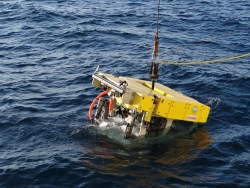Expedition to Emperor Seamount Chain in Pacific Ocean is completed

The RV Akademik Lavrentyev has completed a large-scale expedition organized by the A.V. Zhirmunsky National Scientific Center of Marine Biology (NSCMB FEB RAS) to explore deep-sea ecosystems of the Emperor Seamount Chain.
The Emperor Seamounts are about 39–85 million years old. These seamounts comprise most part of the Hawaiian-Emperor Chain, which stretches from the Hawaiian Archipelago northward, to the Aleutian Islands. The ecosystems associated with the Emperor Seamounts attract keen interest of researchers, because they can help to understand the patterns of deep-water organisms’ distribution and oceanic productivity variations, to evaluate mineral and biological resources and the effect of human activity and global climate change on marine life.
During 53 days of the expedition the ROV Comanche-18 worked at depths over 2200 m, where it recorded dozens of hours of video and took thousands of underwater organisms’ photos. Unique data has been collected on the biological resources and structure of bottom communities found on the slopes of the Milwaukee Seamounts, situated in the southern part of the Emperor Chain. Researchers have identified indicator organisms of vulnerable deep-sea ecosystems of these seamounts–octocorals and glass sponges, collected new data on them, and made their biogeographical description. New data has also been obtained on echinoderms (sea urchins, holothurians, starfish, etc.) and commercially valuable decapod crustaceans. Preliminary studies have revealed dozens of new for this part of the ocean genera and species, many of which are also new for science.
The researchers have for the first time found out interannual variability of gas composition and geochemical characteristics of water over the Emperor Chain and established year-to-year variation in the distribution of methane by depths. More than 500 individual organisms and hundreds of biological samples for the “Marine Biobank” Shared Research Facility have been taken. In addition, researchers have collected animals, ground and water samples from these seamounts for metagenomic investigation. A lot of valuable biological material has been found and stored for obtaining bioactive compounds.
“Our expedition was conducted under harsh conditions of the open ocean. It has successfully fulfilled all the goals due to excellent work of our strong team: researchers specializing in different fields of study and qualified engineers who controlled the ROV Comanche. New expeditions are ahead of us, as the exploration of this region, promising for the nearest future both from scientific and applied point of view, should continue. Our plans also include a very important for the country region of the Kuril Islands. We are going to investigate the most productive oceanic zone from 100 to 3000 m of depth and its resources. This investigation will expand our area of underwater mountain research in the North Pacific”, commented Tatyana Dautova, Head of the expedition and author of “Emperor Seamount Chain Project”, Lead Researcher of the Laboratory of Deep-Sea Research at the NSCMB FEB RAS.
Beside scientists from the NSCMB FEB RAS, specialists from the Far Eastern Federal University, the Pacific Research Fisheries Centre (TINRO-Centre), as well as from key scientific institutions within the Russian Academy of Sciences (the P. P. Shirshov Institute of Oceanology, the V.I. Il'ichev Pacific Oceanological Institute, the Institute of Marine Technology Problems and the V.I. Vernadsky Institute of Geochemistry and Analytical Chemistry) took part in the expedition.
The expedition was organized within the framework of the Year of Science and Technology. The material collected will be studied under the project “Fundamental problems of research and conservation of deep-water ecosystems in the potentially ore-bearing areas of the Northwestern Pacific”, supported by the Russian Ministry of Science and Higher Education.